Gallery
The Influence of Textiles on Corona Discharge Created Around a Human Fingertip
Izabela Luiza Ciesielska, Józef Masajtis
- Technical University of Łódź
- Institute of Textile Architecture
ul. Żeromskiego 116, 90-543 Łódź, Poland
E-mail: iciesielska p.lodz.pl
p.lodz.pl
Abstract
A corona discharge is a visible, electrical discharge observed in gases, which occurs on the surface of charged conductors. In our research, the discharges were generated around human fingertips and recorded in the form of films during the test while a number of people were in contact with different textiles for a short period. The aim of our experiments was the estimation of the possibility of using corona-discharge-films (CDF) for the investigation of the impact of textiles on the CDF of human fingertips. This article describes the investigation, aimed at determining if a test-person’s short period of contact with textiles, such as knitted acrylic, wool and viscose fabrics, influences the corona discharge of the test-person. The research results confirmed these assumptions.
Introduction
Currently, there is great interest in the comfort of garments use. Extensive scientific research carried out in the 20th and 21st centuries prove that the subject of textile improvement is still relevant. For example, research concerning the influence of textiles on human subjects. It turns out that the “perfect” textile product should not only fulfil the criteria of thermal and humidity comfort, but also the criteria of aesthetics and high functionality. So far, most of the research in this area has focussed on thermal or thermophysiological comfort questions with limited or lack of concern about other kinds of comfort, e.g. sensorial.
A certain manner of comfort investigation consisting of catching the changes in the life parameters of humans that uses the textile product was elaborated. The most commonly analysed parameters, which are measured during textile usage, are the temperature and air humidity of the microclimate between the skin of the user and the cloth, the frequency of muscle shrinkage during rest and physical activity, the basic life parameters of the user of textiles, the measurement of electrostatic loads generated on the surface of textiles, etc. [1 - 3].
However, some researches are dealing with the interdisciplinary aspects of the experiments. They propose complex research on the influence of textiles on humans and the feeling of the user towards textiles. Gwosdow & Stevens et al. [4] made an attempt to estimate in what external conditions it is easier to accept textiles. It concerns the sensation question of skin friction caused by textiles. It was proved that if the skin wetness and textile pressure on the skin increase during skin friction caused by textiles, it is less pleasant for textile users. The textiles seem to be rougher. It decreases the acceptability of the product. The wetness on the skin surface causes the sensation of intensified friction and the lack of acceptance for such textile products. The trends of textile sensation, their perception and preferences, seem to be up-to-dated and scientists often raise these matters. Kim & Tokura et al. [5] focused on textile users exposed to cold. They checked how fast from the cooling down moment users wear clothes and what kind - thin or thick. It was proved that with the same exposure to cold, users were choosing thick clothes in the morning and thin in the afternoon. Having this research as a base, the authors carried on with their analysis and questioned when a user feels cold and what kind of cloths he/she chooses – soft or hard. The results show that soft clothes were chosen when the ambient temperature decreased from 33 °C to 25 °C. As a reason for this reaction, a behavioural thermoregulation of the user’s organism was suggested. The touch of the softer cloths evoked a feeling of warmth in users.
Wong & Li et al. [6] presented the same clear trend. They analysed the conne-ction between the physiological and psychological reaction of the human organism when a tight aerobic dress is worn. The results show that both physiological and psychological reactions depend on the effect time of the aerobic dress, external conditions and interactions between these factors. To investigate the connections between the skin’s microclimate temperature and humidity (the physiological reaction) and the sensation of temperature change, humidity and overall comfort of the users (psychological reaction) a multiple regression was used. The results show that overall comfort depends most on the sensation of differences in temperature.
The presented literature review shows only certain possibilities of carrying out research and possibilities which are seen by scientists in the sphere of analysing feelings and reaction of human organism connected with textiles. The attempts of scientific judgements between measurable and non-measurable aspects give not only the possibility of broadening knowledge and discovering the nature of reaction on external stimuli, but also is a step forward in the increasing of overall comfort.
The unilateral scientific approach e.g. only the analysis of feelings, perception without considering physiological parameter changes and reverses, will not guarantee success and not allow a step forward to better understand of the influence of textiles on the human subject, and what is more may lead to misleading conclusions. The method, which we present in this article, and which connects both factors, may allow analyses of interactions between perception, physical and physiological phenomenons,
happening on account of human contact with textiles. An innovatory action, which uses an unconventional method to reveal the influence of textiles on humans, is proposed. It consists in using
corona discharge film (CDF), which records the phenomenons created as an effect of the recombination of electrons in the sweat and are surrounding a part of the human body, which is placed in a high – voltage and high frequency electromagnethic field as in air that surrounds this body part. The electrons that come from live matter may reflect the state of the matter [7 - 9].
The corona discharge and state-of-the-art corona discharge films (CDFs)
The occurrence of the phenomenon – the visible discharge around solid bodies has been known for some centuries, beginning with the St. Elmo’s fires on the tops of sail-ship masts, but was rendered famous only in the 1950s, owing to studies carried out by Semyon Dawidowicz Kirlian (1900-1980); hence it became known as Kirlian photography. Many relations concerning corona discharge photography (CDP) appeared some time ago thanks to Kirlian, but the phenomenon itself was first noticed by German scientist Georg Christoph Lichtenberg (1742 - 1799). He discovered in 1777 that electrical discharges existing around dusts have highly differentiated shapes and characters. Although these bright shapes, which are around objects, are named Lichtenberg’s figures at the moment,
he couldn’t find any use for them.
Jacob Jodko-Narkiewicz (1847 - 1905), photographer and doctor, a Polish explorer of the 19th century, who carried out research into electromagnetism, also became famous in the field of visible discharges. Next, in Prague, in the 1930s Pratt and Schlemmer studied so – called "contact photography" of different objects placed on photography emulsion in an electrical field. Kirlian with his wife Valentine Ksisunova successfully continued all this analyses in the Soviet Union. Kirlian was working in a hospital as an electrotechnician and while repairing a massage device, he suddenly noticed the electrical discharges between the patient's skin and electrode of the device. He then designed an apparatus allowing him to record this phenomenon. Next, the Kirlians continued research into electrical discharges and in 1949 patented the device for the registration of electrical discharge photography, and published the research results [12]. Kirlian, as the first researcher, indicated that corona discharges differ in relation to the physiological and psychological state of the tests person.
The state-of-the-art analysis in this area of knowledge shows certain development, including the computerisation of capturing the discharge image. Since that moment, a CDP, also known as bioelectrophotography, has been described as a method used to reveal and record corona discharges created around an object, e.g., human fingertips, which are the best available parts for testing, in the form of photography as well as film. An image can be induced when a strong electrical field of high voltage (e.g. 1 – 100 kV) and high frequency (e.g. 1 kHz – 3 MHz) is produced. A digital camera placed within the area of corona discharge records this phenomenon as CDPs and CDFs.
The analysis of the phenomenon of corona discharges was carried out by Loeb [13]. He found that the majority of differences in corona discharges recorded by different scientists appeared not only because of the various parameters of the device used for generating and recording the discharges, but also because of the different air humidity, temperature and air pressure in the area that surrounds the device, as well as, the photographic paper used. Other factors impacting corona discharge are the shape of the electrodes and distance between them, and the parameters of the generated field (voltage and high frequency, shape of the impulses). Next, researches carried out by Opalinski [14] and by Pehek & Kyler et al. [15] also proved the significant influence of the film type, but what is more important brought the question of the human skin wetness, which may be treated as a parameter that influence the corona discharge shape. Schroender & Ostrander [16] indirectly considered the human skin wetness factor. According to them, there is a possibility of catching, by CDP, the emotional and physical state of the person under test around whose fingertips a discharge is generated. By catching the emotional state by CDP one should understand the discharge created around the human fingertip from which through skin pores the sweat expelled. In fact, authors recorded discharges in liquid (sweat) – limited in the total discharge, and in gas (air surrounding the finger and evaporated sweat) by the ionisation process. As ionisation takes place also in the evaporated sweat, the sweat chemical composition and proportion of the ingredients depending on health state of the organism (e.g. stress, illnesses) have a significant meaning. Hence, in the publication of Schroender & Ostrander [16] as well as in work of Hoosain & Williams [17] appeared the information about the possibility of registration
of human emotional state by the means of CDP.
The sweat consists primarily of water ~ 99% as well as a smaller amount of sodium chloride, urea, lactic acid, saccharides and other compounds (e.g. potassium, calcium, magnesium, iron) that is excreted by the sweat glands in the skin. Sweat also contains odorants 2-methylphenol (o-cresol) and 4-methylphenol (p-cresol). There are two kinds of sweat glands, and they differ greatly in both the composition of the sweat and its purpose: Merocrine sweat glands used for body temperature control are distributed over the entire body surface, but are particularly abundant on the palms of hands, soles of feet, and on the forehead. These produce sweat that is composed chiefly of water with various salts. Apocrine sweat glands produce sweat that contains fatty materials. These glands are mainly present in the armpits and around the genital area and their activity is the main cause of sweat odour, due to the bacteria that break down the organic compounds.
The excessive sweating is commonly associated with shock and illnesses (e.g. diabetic, tuberculosis, thyroid dysfunctions). The amount of mentioned above sweat substances in the sweat covering the fingertip skin determines the character of the discharge created around the fingertip. Irrespective of that, the significant differences between CDPs of different chemicals were proved [18, 19].
The mechanism of discharges in gases
The phenomenon that is observed, among others, around the fingertips is called an electrical visible discharge in air (Figure 1), and takes often the form of a corona [13, 21, 22]. The very complex processes, which are characterised by a high voltage - high frequency electromacnetic field, are only briefly signalised in this article by the following description, as it was not the aim of our work to analysed the character of the electric processes proceeding [19 - 25].

Figure 1. The discharge created around a fingertip, recorded in original natural colours [20]. View from underneath, through a semi-transparent glass electrode that provided electrical field excitation.
Remark: Figure 1 in the Internet version of the journal is presented in colour.
The typical system that generates a corona is a point-surface system. The discharge mechanism depends on the polarity of the potential of the point. The coronas with positive and negative polarity have certain mechanisms in common.
A neutral atom or molecule of the medium, in a region of strong electrical field (such as the high potential gradient near the curved electrode (e.g. the fingertip plays such a role) is ionised by an exogenous environmental event (for example, as the result of a photon interaction), to create a positive ion and a free electron. The electric field then operates on these charged particles, separating them, and forcing their recombination, and also accelerating them, imparting each of them with kinetic energy. As a result of the energisation of the electrons (which have a much higher charge/mass ratio and so are accelerated to a higher velocity), further electron/positive-ion pairs may be created by collision with neutral atoms. These then undergo the same separating process creating an electron avalanche (Figure 2). Both positive and negative coronas rely on electron avalanches.
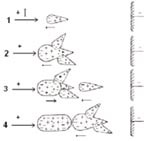
Figure 2. The scheme of development of discharge in the heterogeneous field for the point with positive polarity; I – the electrical current [22 - 24].
The authors used a GDV Camera to generate and record a positive corona discharge created around human’s fingertips.
The positive coronas
A positive corona is manifested as uniform plasma across the length of the element which emits the electric discharges. It can often be seen glowing blue/violet (Figure 1), though much of the emissions are in the ultraviolet. The light is differently coloured in each gases case because of the different wavelengths of light that must be released in each instance. With the same geometry and voltages, it app-ears a little smaller than the corresponding negative corona, owing to the lack of a non-ionising plasma region between the inner and outer regions. There are many fewer free electrons in a positive corona, when compared to a negative corona, except very close to the curved electrode: perhaps a thousandth of the electron density, and a hundredth of the total number of electrons. However, the electrons in a positive corona are concentrated close to the surface of the curved conductor, in a region of high-potential gradient (and therefore the electrons have a high energy), whereas in a negative
corona many of the electrons are in the outer, lower-field areas. Therefore, if electrons are to be used in an application, which requires high activation energy, positive coronas may support greater reaction constants than corresponding negative coronas [21 - 25].
Materials and methods
The aim
The aim of the investigation was to check the influence of the kind of clothing worn by the person under tests on their psycho – physical state visualised by the corona discharges around fingertips of the person under tests.
Numerous previous studies involving corona discharges have provided evidence that discharges generated around non-living objects, e.g., coins or stones; do not change their form or shape over time. Corona discharges generated around living organisms are characterised by variations over time [7 - 9, 12]. This observation suggests that exogenous environmental events, lifestyle, garments and physical state (also mental state in humans) of study objects may influence corona discharges generated around a given animated object.
The test-persons
All 20 volunteers were selected as test persons (9 men, aged 21 - 54 years, mean 46 ± 11 years and 11 women, aged 21 - 57 years, mean 35 ± 12 years), they were eligible for the study. All were informed about the purpose, the manner of carrying out the experiment and they were all trained how to place the finger on the plate in the same manner with the same pressure. All tests were performed at room temperature of 18 - 25 °C, relative humidity of 28 - 64 % and atmospheric
pressure of 986 - 1010 hPa.
The reasons why the authors made the proposition of carrying out the research, in the way described below in details, involving a ring finger was fallowing:
- no reports concerning the analysis of a short period influence of textiles on corona discharges created around a human fingertips or other parts of his body,
- as fingertip’ imprints are similar in their shape to an ellipse, it is easy to analyse it from mathematical point of view,
- the access to fingers is easy (almost always uncovered),
- the selection of the ring fingertip was chosen as this finger seems to be the “most sensitive” according to some neurophysiologists [26, 27]. A rational explanation was found in neuroanathomy of a right hand ring finger of human being. It was proved that ring finger is more sensitive than any other by carrying out test [26].
The examination methods
Examination methods comprised:
1) a questionnaire-based rating of test person’s frame of mind, including a 15-item scale with categories of responses ranging from extremely poor to extremely good frame of mind;
2) heart rate (HR), blood systolic and diastolic pressure (BP), the level of stress measured by a stressmeter recording tremor of the nervous at rest;
3) generation and registration of CDFs of ring fingertips of right hand. The other hand contacted with textiles. A volunteer bared his forearm from wrist to elbow and wore on it a knitted textile, a kind of sleeve made of 3 different raw materials, e.g. firstly of coarse wool. The ring finger of right hand was placed on the plate of the GDV device and a 32-second long film of corona discharge around fingertip was recorded. The procedure was repeated immediately with usage of two other sleeves, acrylic and viscose. As a references a CDF was recorded when the forearm was bare. That procedure was repeated totally 5 times for the results conformation. Volunteers were dressed each time the same, generally cotton garments.
CDFs were recorded with use of the GDV Camera, parametric images were analysed with use of the GDV Processor Program. A multiple regression was used to analyse the effect of the objects’ examination conditions, frame of mind, level of stress, their age, gender, menstrual cycle, HR, BP on parameters of CDFs of volunteers.
An important element is the time of exertion an effect by textiles on human being (60 second in this experiment).
In the preliminary stage of this research, the authors made an attempt to check if the order of getting in contact with sleeves has an impact on results, e.g. if the volunteers first wears the coarse wool and next the acrylic sleeve and opposite. The results show that there are differences but not statistically significant in CDFs’ parameters when comparing the order of getting in contact with sleeves.
Sets of garments
The decision about the choice of the raw material for experiment purpose was made on the basis of the fallowing prerequisites:
- Raw materials for garments which are in general use.
- Raw material of natural and synthetic origin.
- Different accumulation of electrostatic charges caused by friction of the materials and its ability for generation of the electrostatic charge by those materials.
- Hand feel difference between chosen materials.
- The sleeves were manufactured by knitting with plain stitch. The wale stitch density was 36 columnes/1dm and the course stitch density was 54 rows/1dm in all knitted plain stitch fabrics.
The textiles and the corona discharge
The position of materials in static tribological order is already well - known. To analyse the influence of textiles on CDFs’ parameters of human beings staying in short period contact with those textiles, three different raw materials were chosen:
coarse wool – natural, animal fibre (+++), viscose - man – made natural polymer fibre (++), and acrylic – man - made synthetic polymer fibre (-).
The Bioethics Committee of the Medical University of Lodz, Poland approved the study design (RNN/336/05/KB).
The apparatus
1) Gas Discharge Visualisation Camera (GDV C) used to record CDFs.
Technical data of GDV C:
- 4 levels of voltage settings: 10 - 20 kV,
- the length of the electrical impulse: 10 microsecond,
- frequency: 1024 Hz,
- time of exposition in the high voltage and high frequency field: 0.5; 1.0; 2.0; 32 second,
- recording of 10 frames per second,
- mass of the device: 5 kg,
- dimensions: 39.5 × 16.5 × 34.5 cm,
- registration of monochromatic pictures.
2) Pressure-gauge for measuring the systolic and diastolic blood pressure with a heart rate measuring system.
3) Stressmeter Comby – Tremor Monitor ADT M 50, produced by the Institute Bruno Comby, Honilles, France. It measures the level of tremor nervous system at rest and reacts on the tremor of the muscles.
The procedure of induction corona discharge
An object is placed on the optic plate (1) of the system used to visualise CDF (Figure 3), the voltage generator (4) is switched-on, providing a voltage of 10 kV and frequency 1024 Hz. In the induced electrical field, charge carriers (free electrons and positive or negative ions) (3) present in the air surrounding the surface of optic plate (2) and the object (1) collide with other charge carriers interacting with one another. The electrical impulses, transmitted to the plate after placing an object on it and switching on the generator, stimulates the response of the object, called inter alia, by the movement of the charge carriers. An acceleration of their movement constantly occurs in the conditions of a stable ionisation processes evoked by charging influenced by the high frequency current [9].
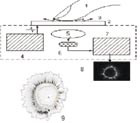
Figure 3. The system used to visualize CDP and CDF along with the processed CDP; 1. study object; 2. optic glass plate connected to a power source; 3. discharge; 4. voltage generator; 5. optic system; 6. CCD camera (Charge-Coupled Device system with charge-coupling); 7. image transducer; 8. image of discharges on the computer monitor; 9. processed and analysed image of discharges.
The occurrence of ionisation collisions creates an electron avalanche [25]. Free electron re-association is followed by a visible glow. This phenomenon is recorded around the fingertip (Figure 3).
Although the change of garments is often accompanied by the change in mood or comfort (see Introduction), those feelings are difficult to define. This kind of research attempts to determine the general influence on people’s feelings by the impact of clothing textiles.
Eight parameters of the single 32-second long film from a corona discharge around a fingertip were gathered. In total, 80 CDFs (20 volunteers × 4 CDFs). Additionally, seven descriptive parameters of each volunteer and three parameters of the ambient environment were recorded.
The CDF parameters are:
1) The number of pixels of glow image - the number of pixels which were not removed from the picture during the filtration process.
2) The glow area – number of pixels with non-zero intensity after filtration (filtration value brings the deleting of a part of the brightness spectrum range 0 - absolutely black ÷ 255 - absolutely white to the 0 – 225).
3) The average value of intensity for all the pixels from glow image, the used scale of glow is from 0 – black to 255 – white (maximum intensity of glow).
4) The form coefficient – quotient of the isoline length and the average radius multiplied by 2π, reflects a degree of irregularity of the glow contour.
5) The length of isoline – the length of the curve of the glow contour corresponding to the average intensity.
6) The average radius – average value of the function R(a) = Rmax - Rmin by the angle of inclination of the beam a in [0°; 360°], drawn from the glow centre to the nearest dot Rmin and the most distant from the centre Rmax with the intensity 1 more than the noise level set on 30- the best for registration the CDFs of fingertips of humans according to Prof. K. Korotkov, DSc.
7) Number of free fragments that glow area consists of.
8) The normalized deviation of isoline radius – quotient deviation of the function R(a) to the average radius of the glow; entropy by the isoline is defined as
S(M) - ∑ Pj (M)ln (Pj(M))
where: Pj(M) = Nj/Nm denotes the function of allocation of the radius of dots by the isoline of the picture, e.g. probability of value j (Nj – number of dots with equal value by the isoline) among dots of the isoline length M (Nm – number of all dots on the isoline). Since variations of different values can be very high, division into even intervals is used.
The life’s parameters are:
9) The systolic blood pressure.
10) The diastolic blood pressure.
11) The HR,
12) The age,
13) The day of the menstrual cycle – in case of female volunteer,
14) The level of stress measured by stressometer,
15) The mood - a questionnaire-based rating of volunteer’ feelings.
The parameters of the ambient environment are:
16) The air temperature in °C.
17) The air humidity in %.
18) The air pressure in hPa.
Results and discussion
Numerous CDF of all persons under test were studied. As examples, selected frames from CDF recorded around a fingertip of right hand ring finger of a female aged 54 years are presented in Figure 4 (a, b, c, d).
a)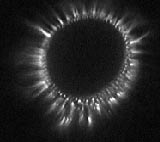 b)
b) c)
c)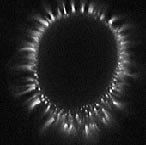 d)
d)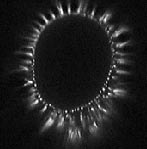
Figure 4. Chosen frames from the CDF recorded around a fingertip of a female volunteer during a short period of contact with: a) 100% acrylic, b)100% viscose, c) 100% coarse wool knitted sleeves, and d) when the forearm stayed bare.
The graphs presented in Figure 5 were created on the basis of CDFs recorded for a fingertip of the right hand of the same 54 years old female volunteer and present the dynamic of corona discharges during the contact with different textiles, as changes of the glow image (in pixels) with time.
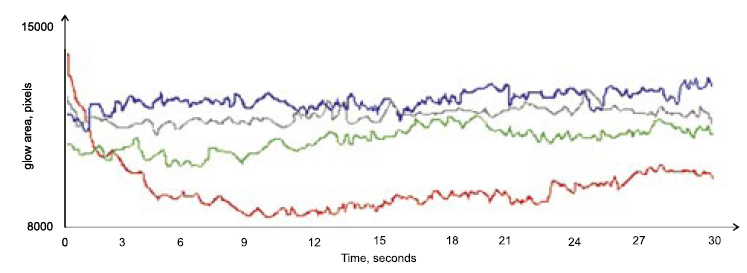
Figure 5. Dynamic of corona discharge areas changes in time for contact with knitted fabrics made from: red line - acrylic, green line - viscose, black line - coarse wool; and for dark blue line - bare forearm.
The most often appearing classification (order of sleeves from the point of view of the influence on CDFs’ parameters) in this study suggests that the smallest corona discharge area - glow image was achieved when volunteers were in contact with acrylic sleeve, larger – when volunteers were in contact with viscose sleeve, next with coarse wool sleeve and the biggest area of glow was noted when volunteers were not in contact with any sleeve and their forearms were bare.
The order of appearing the lines in the graph (Figure 5) as well as the dynamic of their changes are individual and characteristic for each person.
Statistically significant differences were stated between the mean values of parameters of CDFs recorded during volunteers’ contact with lack of sleeve and acrylic, coarse wool, and viscose sleeve, between acrylic sleeve and coarse wool and viscose sleeve, and between viscose and coarse wool sleeve (p<0,05 in all cases).
There is a correlation r = 0.35 between the mood of the volunteers described by them by the means of a questionnaire, including a 15-item scale with categories of responses ranging from extremely poor to extremely good frame of mind and the level of stress measured by the means of the stressmeter. The level of stress impacts chosen CDF’s parameters, such as: the average radius, and the number of free fragments that glow area consists of. The higher value of these parameters, the higher level of stress. Knitted sleeves do not interfere that process.
There is a dependence between ambient air conditions and the parameters of CDFs. The air temperature, air pressure and air humidity are factors that influence all the CDFs’ parameters.
The higher air temperature and air pressure the higher the average value of intensity for all the pixels from glow image.
The higher air humidity the higher average value of intensity for all the pixels from glow image and the shorter the average length of radius. That is in agreement to findings of Loeb [13] and Opaliński [14]. A dislocation of the positive and negative ions and electrons plays an important role in the corona discharges. Their mobility – the speed of their movement on the electrical field’s lines, which is generated by GDV C, depends on the ambient air conditions. Ions are able to join the H2O particle, which reduces the possibilities of ions mobility. It should be emphasised here that the great difference in the air humidity during an experiments make it more difficult to analyse from the point of view of relations with short period of contact with sleeves.
There is an influence of the female menstrual cycle on female CDFs’ parameters. At the beginning and at the end of the cycle the CDFs’ parameters achieved higher values of their standard deviations than the CDFs’ parameters recorded in females in the middle of their cycles.
Knitted sleeves do not interfere that process.
The HR as well as blood diastolic and systolic pressure of volunteers impact the parameters of their CDFs. It means that the physical state of the volunteer may impact his CDFs’ parameters.
Conclusions
The invesitgation carried out by us allows to formulate the following conclusions:
1. There is an influence of the kind of the raw material of a part of the clothing on the corona discharge images of the person under test. It was confirmed by statistically significant differences between the corona discharges related to particular raw materials.
2. There is an influence of the psychical state of the test-persons, expressed by the questionnaire-based rating of test persons’ frame of mind and the stressmeter measurement results on the corona discharge image.
3. There is an influence of the physiological state of the test-persons expressed by HR and blood systolic and diastolic pressure on their corona discharge imags.
4. The corona discharge strongly dependes on the environmental conditions (temperature, air humidity and the air pressure).
5. Consequently, the experiments checking the influence of textile raw material on the mood of persons under test, wearing clothing made from these materials, by comparing the corona discharges of these persons, should be carried out at steady environmental conditions, and for persons in comparable physical and psychical state.
Acknowledgment
Authors would like to express the gratefulness to the Polish State Committee for Scientific Research for support. (No. 3 T08E 051 27).
References
1. Ciesielska I. L., (2001). The identification of features increasing the friendliness of textiles. The master thesis. The Technical University of Lodz.
2. Ciesielska I. L., (2007).The Analysis of the influence of textiles on corona discharges.
Doctoral dissertation. The Technical University of Lodz.
3. Zimniewska M., Huber J., Krucińska I., Torlińska T., Kozłowski R. (2002). The Influence of natural and synthetic fibres on electromyographical parameters of muscles tension. 2nd Autex Conference.
4. Gwosdow A. R., Stevens J. C., Berlund L. G., Stolwijk J. A. (1986). Skin Friction and Fabric Sensation in Neutral and Warm Environments. Textile Research Journal.
5. Kim H. E, Tokura H., Nagashima, R., Nishizawa, K. (1995). Do cooled women select soft or hard clothing. Journal of Thermal Biology, vol. 20, no.4, p.327-332.
6. Wong A. S. W, Li Y. (2004). Relationship between thermophysiological responses and psychological thermal perception during exercise wearing aerobic wea. Journal of Thermal Biology 29, p.791-796.
7. Iovine, J.(1994). Kirlian Photography, a hands- on guide. TAB Books, USA.
8. Korotkov K. (1998). Aura and Consciousness, a new stage of Scientific understanding. State Editing & Publishing Unit „Culture”.
9. Korotkov K. (2002). Human Energy Field. Study with GDV Bioelectrography. SPIMFO.
10. http://www.geocities.com/neveyaakov/electro_science/lichtenberg.html
11. http://pl.wikipedia.org/wiki/Sieml
12. Kirlian S. D., Kirlian W. Ch. (1961). Fotografirovanie i wizualnoje nabludenie pri posredstwie took wysokiej czastoty. Żurnal naucznoj i prokładnoj fotografii i kinematografii.
13. Loeb L. B. (1995). Electrical Coronas – Their Basic Physical Mechanisms. University of California Press.
14. Opaliński J.; (1979). Kirlian – type images and transport of thin-film materials in high – voltage corona discharges J.Appl. Phys. 50 (1).
15. Pehek J., Kyler H., Faust D. (1976). Image Modulation in Corona Discharge Photography. Science, 194 (4262).
16. Ostrander S., Schroeder L. (1970). Psychic Discoveries Behind the Iron Curtain. Prentice – Hall.
17. Hoosain E., Williams R. (1982). Kirlian Photography – an appraisal. Journal of Audiovisual Media in Medicine, 5, p. 84-91.
18. Śkarja M. Berden M., Jerman I. (1998). Influence of ionic composition of water on corona discharge around water drops. Journal of Applied Physics, vol. 84, no 5.
19. Korotkov K., Krizhanowsky E., Borisova M., Korotkin D., Hayes M., Matravers P. (2004, April). Time dynamics of the gas discharge around drops of liquids. Journal of Applied Physics, 95 (7).
20. http://kirlianresearch.com/kirlian_principle.html
21. Korczyński A. (1982). Procesy elektrofotograficzne. Wydawnictwa Naukowo-Techniczne, Warszawa.
22. Mosiński F. (1991). Podstawy technik wysokich napięć. Politechnika Łódzka.
23. Flisowski Z. (2002). Technika wysokich napięć. Wydawnictwa Naukowo-Techniczne. Warszawa.
24. Szymanowski W., (1965). Elektrofotografia. Praca zbiorowa. Wydawnictwa Naukowo – Techniczne, Warszawa.
25. Naidu M. S., Kamaraju V. (1996). High Voltage Engineering (2nd Edition). McGraw-Hill.
26. Schweizer R., Maier M., Braun C., Birbuumer N. (2000). Distribution of mislocalizations of tactile stimuli on the fingers of the human hand. Somatosensory Mot.Research, 17(4), p. 309-16.
27. Stappaerts K. H., Van Hees J., Van den Broeck E. A. (1993). Peripherial cutanoeus nerve distribution to the fingers Somatosensory Mot. Research, 10(4): 455-65.
- Login to post comments
User login
Last articles










